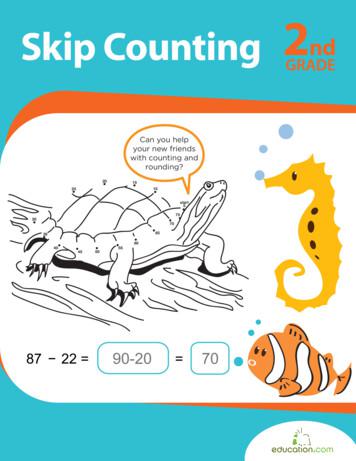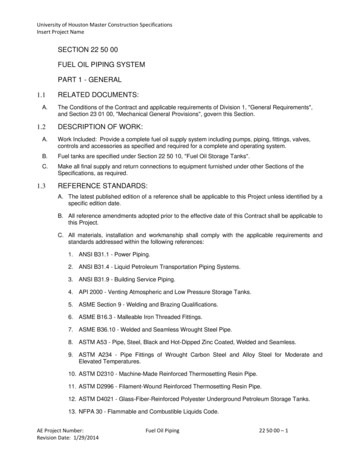Lewis Dot Diagrams & Ions
Lewis Dot Diagrams& IonsS2-2-01 Relate an element’s position on the periodic table to its combiningcapacity (valence).
Lewis dot diagrams In grade 9, you learned how to represent the atom by using Bohr Diagrams.Since Bohr diagrams can be a bit cumbersome to draw, we can use a shorter,more convenient notation.Lewis Dot Diagrams (Electron Dot Diagrams) A Lewis dot diagram is a way to represent an element and its VALENCEelectrons. In a Lewis dot diagram, DOTS or other small symbols are placed around theCHEMICAL SYMBOL of an element to represent the valence electrons. Electrons are either PAIRED or UNPAIRED. The first 4 ELECTRONS will alwaysbe UNPAIRED (except Helium, which has two dots that are paired). THE NEXT 4 ELECTRONS WILL PAIR UP WITH THE FIRST 4 DOTS. All elements in the same group/family will have SIMILAR Lewis dot diagramsEXCEPT He.
Lewis dot diagrams Examples:Draw Bohr AND Lewis Dot diagrams for the following elements.ElementHeliumPotassiumBohr DiagramLewis DotGroup #
Lewis dot diagrams Examples:Draw Bohr AND Lewis Dot diagrams for the following elements.ElementCarbonPhosphorusBohr DiagramLewis DotGroup #
Lewis dot diagrams In the table below, Write the name of each family above its column and drawthe Lewis dot diagram for the first 18 elements of the periodic table.Questions?1. Why might elements of the same group/family have similar properties?
Lewis dot diagrams Questions?2. Which family is likely to want to:a) Lose 1 electron?b) Gain 2 electrons?3.Choose 2 elements that you think may be likely to “combine”. Give a reasonfor your answer.4.What do you think determines the “combining capacity” (how elementscombine) of an element?
Charged Atoms Why is it so dangerous to use electricity around water? Tap water is not PURE! It contains CHARGED ATOMS that move inthe solution and can carry ELECTRIC CURRENT.We call these charged atoms IONS. An atom gets a charge by having aDIFFERENT amount of ELECTRONS than PROTONS.Since PROTONS are STUCK in the nucleus, atoms can only gain or loseELECTRONS to FILL the OUTER SHELL and get a charge.
Negative Ions If an atom GAINS ELECTRONS, it becomes MORE NEGATIVE, and is aNEGATIVE ion.Ex) Draw a bohr diagram for the following, and determine the ion thatthey would likely form:1. Oxygen2. Fluorine
Positive Ions If an atom LOSES ELECTRONS, it becomes LESS NEGATIVE, and is aPOSITIVE ion.Ex) Draw a bohr diagram for the following, and determine the ion thatthey would likely form:1. Lithium2. Beryllium
Examples Determine the charge on each of the following, and write the symbol for rogen
Try these ones 1. What is the ionic charge if Calcium loses its valence electrons?Write the ion using the chemical symbol with the charge properly.2. a) How would sulphur “fill” its outer electron shell?b) What would be the charge of the resulting ion?c) Write the correct symbol and charge for the sulphur ion.
Things we need to consider Do you notice what types of elements lose electrons and which onesgain electrons? Why don’t atoms gain/lose protons? What would result if they did? What would happen if they gained or lost neutrons?
Lewis dot diagrams In grade 9, you learned how to represent the atom by using Bohr Diagrams. Since Bohr diagrams can be a bit cumbersome to draw, we can use a shorter, more convenient notation. Lewis Dot Diagrams (Electron Dot Diagrams) A Lewis dot diagram is a way to represent an element and its VALENCE electrons.
Metals vs. Non-Metals; Dot Diagrams; Ions Metals versus Non-Metals Dot Diagrams Metals are on the left side. Non-metals on the right. Metals tend to lose electrons. Non-metals gain them tight. Dot Diagrams (sometimes known as Lewis dot diagrams) are a depiction of an atom’s valence elect
Skip Counting Hundreds Chart Skip Counting by 2s, 5s and 10s to 100 Counting to 120 Dot-to-Dot Zoo: Count by 2 #1 Dot-to-Dot Zoo: Tapir Count by 2 Dot-to-Dot Zoo: Antelope Count by 2 Dot-to-Dot Zoo: Count by 2 #2 Dot-to-Dot Zoo: Count by 2 #3 Dot-to-Dot Zoo: Count by 3 Connect the Dots by 5!
(3c) ·Lewis dot diagrams are used to represent valence electrons in an element. Structural formulas show the arrangements of atoms and bonds in a molecule and are represented by Lewis dot structures. Draw Lewis dot diagrams to represent valence electrons in elements and draw Lewis dot structures to show covalent bonding.
4.6 Lewis Structures for Ionic Compounds Lewis Structure of Ions of Representative Elements Periodic Table Group Number Lewis electron-dot symbols 2nd period elements Lewis electron-dot symbols of 2nd period ions Lewis symbols of 2nd period ions In the formation of calcium bromide, CaBr 2 Use elec
The Journals of Lewis and Clark. By Meriwether Lewis and and William Clark, 1804-1806. Note: These Journals are from May 14, 1804, the day the expedition left the Mississippi River, to September 26, 1806, a day or two after they arrived back in St. Louis. It includes all possible Journal entries of Lewis and Clark. Most of the "courses andFile Size: 4MBPage Count: 1023Explore furtherJournal Entries from the Lewis and Clark Expeditionwww.lewisandclarkexhibit.orgThe Journals of Lewis and Clark, by Meriwether Lewis and .www.gutenberg.orgThe Journals of the Lewis & Clark Expedition Center for .www.unl.eduHome Journals of the Lewis and Clark Expeditionlewisandclarkjournals.unl.eduJournal Excerpts Discovering Lewis & Clarklewis-clark.orgRecommended to you b
The Lewis Dot Diagram Lewis Dot Diagrams (or Electron Dot Diagrams) Diagrams in which dots are placed around the chemical symbol of an elements to illustrate the valence electrons 1. each dot represents one valence electron 2. the element’s symbol represents the core of the atom (the nucleus and
Bohr Diagrams So far we have used Bohr diagrams to show how may electrons an element has and how elements bond in ionic compounds. For example here is CaF 2. Electron Dot Diagrams There is another model called the electron dot or Lewis diagram. This system represents an atom and its valence elec
ASTM D2310 - Machine-Made Reinforced Thermosetting Resin Pipe. 11. ASTM D2996 - Filament-Wound Reinforced Thermosetting Resin Pipe. 12. ASTM D4021 - Glass-Fiber-Reinforced Polyester Underground Petroleum Storage Tanks. 13. NFPA 30 - Flammable and Combustible Liquids Code. University of Houston Master Construction Specifications Insert Project Name AE Project Number: Fuel Oil Piping 22 50 00 .






















